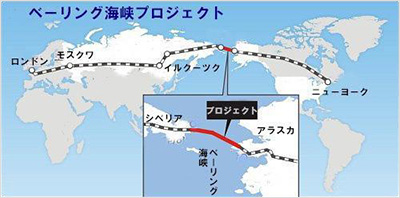We would like to introduce articles about the Japan-Korea Tunnel Project that have been featured in news organizations and media newspapers (magazines).
The only way for the Korean people to survive is through cooperation between the North and South. The Bering Strait Project is a reality, not a dream
Recently, President Lee Myung-bak's visit to Mongolia and Central Asia and Kim Jong-il's visit to Russia became a hot topic.
The fact that the leaders of the North and South coincidentally agreed on the issue of securing energy and transportation networks means that they have a great survival strategy. From August 17th to 19th, experts from various countries including the author, who was the South Korean representative at the Bering Strait Peace Forum supported by the World Peace Tunnel Foundation, and representatives from the United States, China, and Russia participated. An international conference was held on the theme of "Comprehensive Infrastructure Development in the Northeastern Russian Region of the Sakha Republic of Russia."
The main topics of this conference were (1) railway connections between Eurasia and the North American continent, and (2) energy resource development in the Far East. The fact that the topics that the leaders of the North and South took up in the countries they visited and the themes of the Sakha International Conference were resources and transportation networks shows that these are the areas of greatest concern in this region.
In particular, as a peninsular country, we cannot help but be concerned about our future prospects. Furthermore, the time has come for the leaders of the North and South to seek a common survival strategy that will be a win-win for both parties. At this conference, I saw the Bering Strait project being deeply discussed and promoted, and I was made aware that the only way to open up new avenues for the Korean people is through cooperation between the two Koreas. Firstly, the Bering Strait project is a business that will turn the Korean Peninsula into the central region of Northeast Asia.
Connecting the Korean peninsula's railway network with the Trans-Siberian Railway will also give momentum to the much-discussed Korea-Japan undersea tunnel project. If the shortest land route connecting Europe and the Americas is opened, cargo from South Korea, Japan, and Southeast Asia will all be concentrated on the Korean Peninsula. The Korean Peninsula will become the Netherlands of Europe. Second, the railways and oil and gas pipelines that run through the Korean peninsula will strengthen the physical foundations for mutual prosperity between the two Koreas, and will ultimately contribute to creating a unified environment.
The unification of the Korean Peninsula will be a catalyst for the formation of an East Asian community that will change the regional order of Northeast Asia from conflict to cooperation. Third, the Korean Peninsula can become the birthplace of a new civilization that connects the ocean and the continent.
It has been the long-held hope of the countries concerned that the United States, China, Russia, Japan, and a unified Korea come together to create a new civilization oriented toward the common prosperity and improvement of human welfare. The 21st century must become a century of hope, where a new civilization is born where continental and oceanic powers merge.
The Bering Strait project currently underway will not only hasten the economic renaissance era of the global village by inducing the development of Siberia and Alaska, which are rich in resources, but will also contribute to world peace and the construction of a welfare society for humankind. .
Furthermore, the Bering Strait project is of interest to the international community regarding the potential for resource development and shipping routes in the Arctic. The Bering Strait project is no longer a dream but a reality. The age of fusion between the continent and the ocean has begun, in which the long-cherished desire of the Korean Peninsula will be fulfilled. --- (Korea's "Sekai Ilbo", September 2, 2011) [Contribution] John Teik, Korean Ambassador to Russia
 The green light has been given to a plan to dig an undersea tunnel in the Bering Strait between Eurasia and North America and link it to the railway networks of both countries.
The green light has been given to a plan to dig an undersea tunnel in the Bering Strait between Eurasia and North America and link it to the railway networks of both countries.
On August 22nd (local time), the British daily Mail reported that the Russian government has approved a plan to build an undersea tunnel in the Bering Strait by 2030.
Alexander Levintar, Deputy Governor of the Russian Far Eastern Federation, made the announcement at an international conference on resource development held in Yakutsk, attended by experts from the United States, China, and the United Kingdom.
The Bering Strait, which connects Alaska in the United States and Siberia in Russia, is approximately 80 km wide, and the International Date Line runs between Big Diomedes Island (Lyongyin) and Migryonyin (Little Diomedes Som) on the Russian side.
21,000 years ago, some regions appeared above water, and there was active human interaction between Asia and the North American continent. The undersea tunnel to be built here will be approximately 105 km long, and the construction cost is estimated to reach 100 billion dollars (approximately 107.88 trillion won). For this reason, Russia has decided to invest $1.5 billion by 2013 to extend the Trans-Siberian Railway to Yakutsk. Once the undersea tunnel is completed, it will be possible to travel from London, England, to New York in 15 days by train. In addition, resources that used to be transported by ship across the Pacific Ocean can now be moved cheaply and quickly by rail freight. --(Korea "Sekai Ilbo", August 23, 2011)